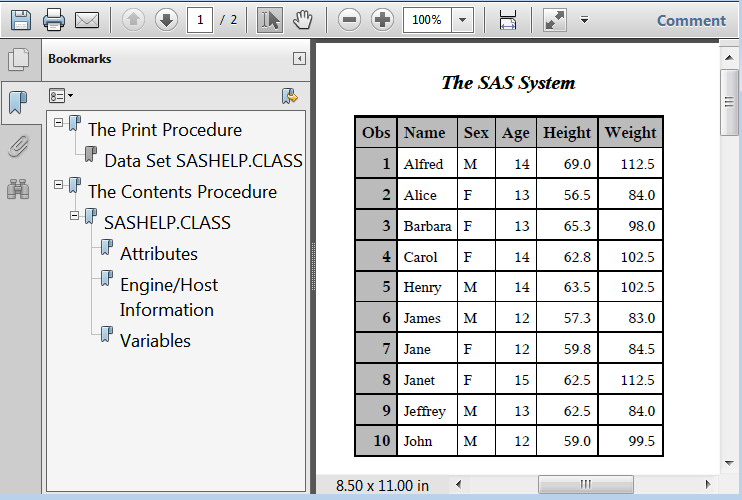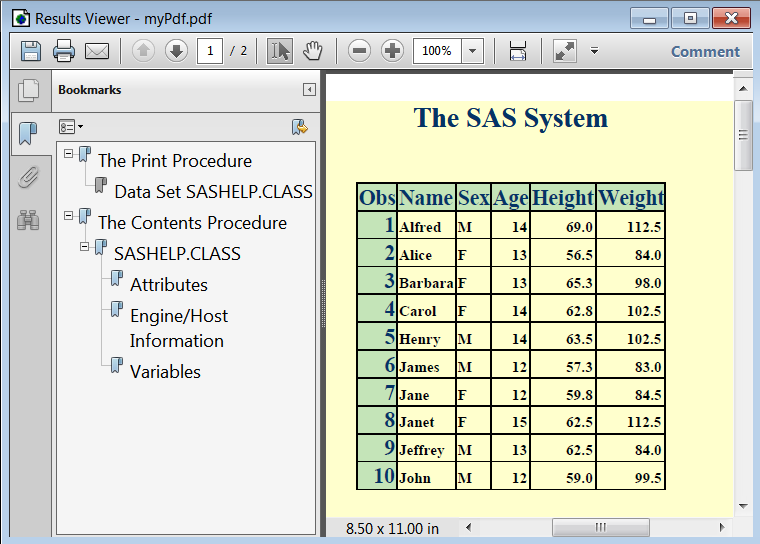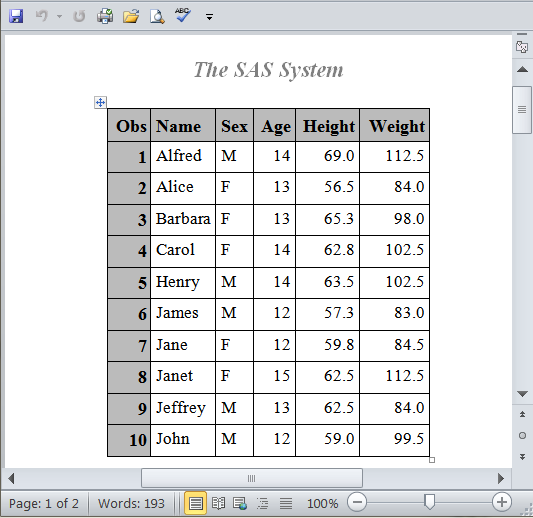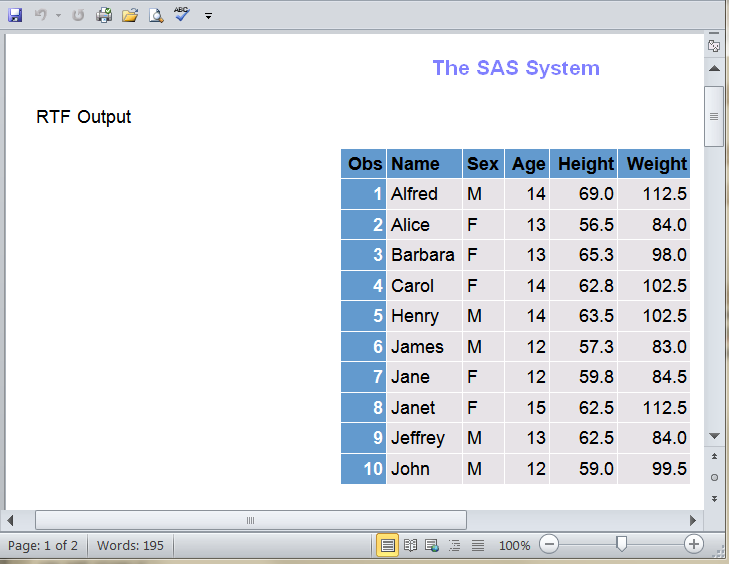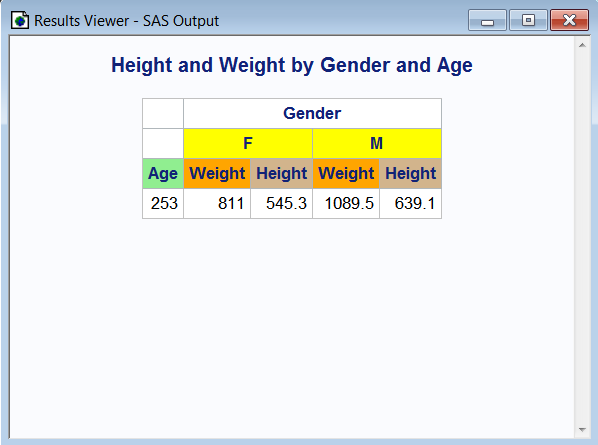Basic Usage
The DOCUMENT Procedure
The combination of the ODS DOCUMENT
statement and the DOCUMENT procedure enables you to store a report’s
individual components, and then modify and replay the report. The
ODS DOCUMENT statement stores the actual ODS objects that are created
when you run a report. You can then use PROC DOCUMENT to rearrange,
duplicate, or remove output from the results of a procedure or a data
query without invoking the procedures from the original report. You
can also use PROC DOCUMENT to do the following:
The DOCUMENT
destination has a graphical user interface (GUI), called the Documents window,
for performing tasks. However, you can perform the same tasks with
batch statement syntax using the DOCUMENT procedure.
For complete documentation on the DOCUMENT procedure, see The DOCUMENT Procedure in SAS Output Delivery System: User's Guide.
ODS Global Statements
ODS global
statements provide greater flexibility to generate, customize, and
reproduce SAS procedure and DATA step output. You can use ODS global
statements to control different features of ODS. ODS statements can
be used anywhere in your SAS program. Some ODS statements remain in
effect until you explicitly change them. Other ODS statements are
automatically cleared. For complete documentation on ODS global statements,
see the chapter about ODS statements in the SAS Output Delivery System: User's Guide.
ODS global statements
are organized into two types.
You can use ODS destination
statements to generate and modify reports in formats such as HTML,
XML, PDF, PostScript, RTF, and Microsoft Excel. The form for an ODS
destination statement is the ODS statement block, which consists of
ODS statements that open and close one or more ODS destinations sandwiched
around your program. Your results are sent to one or more output destinations.
You can use one or more
ODS destination statements, one or more PROC or DATA steps, and an
ODS CLOSE statement to form an ODS statement block. An ODS block has
the following form:
In the ODS block, output-destination is
the name of a valid ODS destination and option(s) are
options that are valid for that destination. Your SAS program is inserted
between the beginning ODS destination statement and the ODS CLOSE
statement.
ODS output-destination 1 <options(s)>;
...
ODS output-destination (n) <options(s)>
<your SAS program>
ODS destination close statement
1;
...
ODS destination close statement
(n)
In the following example,
the output from PROC PRINT and PROC CONTENTS is sent to the PDF and
RTF destinations. The STYLE= option specifies what table template
to apply to the output. By default, the PDF opens in Adobe Acrobat
and the RTF opens in Microsoft Word.
options obs=10 nodate; ods pdf file="myPdf.pdf" style=Banker; ods rtf file="myRTF.rtf" style=BarrettsBlue text="RTF Output"; proc print data=sashelp.class; run; proc contents data=sashelp.class; run; ods pdf close; ods rtf close;
ODS destinations are organized into two
categories.
These destinations
produce output that is controlled and interpreted by SAS, such as
a SAS data set, LISTING output, or an ODS document.
The following table
lists the ODS destination categories, the destinations that each category
includes, and the formatted output that results from each destination.
Base SAS Reporting Procedures
The Base
SAS reporting procedures, PROC PRINT, PROC REPORT, and PROC TABULATE,
enable you to quickly analyze your data and organize it into easy-to-read
tables. You can use ODS options with the reporting procedures to give
your report another dimension of expression and usability. For example,
you can use the STYLE option with a PROC PRINT, PROC REPORT, or PROC
TABULATE statement to change the appearance of your report. The following
program uses the ODS STYLE option to create the colors in the output
below:
Title "Height and Weight by Gender and Age"; proc report nowd data=sashelp.class style(header)=[background=white]; col age (('gender' sex),(weight height)); define age / style(header)=[background=lightgreen]; define sex / across style(header)=[background=yellow] ' '; define weight / style(header)=[background=orange]; define height / style(header)=[background=tan]; run;
TEMPLATE Procedure
All SAS
procedures produce output objects that ODS delivers to various ODS
destinations based on the default specifications for the procedure
or based on your own specifications. Output objects are commonly displayed
as tables, data sets, or graphs. Each output object has an associated
template provided by SAS that defines its presentation format. You
can use the TEMPLATE procedure to view or alter a template or to create
a new template by changing the headers, formats, column order, and
so on.
The TEMPLATE procedure
enables you to create or modify a template that you can apply to your
output. You can also use the TEMPLATE procedure to navigate and manage
the templates stored in template stores. ODS then uses these templates
to produce formatted output. Using the TEMPLATE procedure is an advanced
technique. For
more information about advanced ODS techniques, see Next Steps: A Quick Look at Advanced Features .
